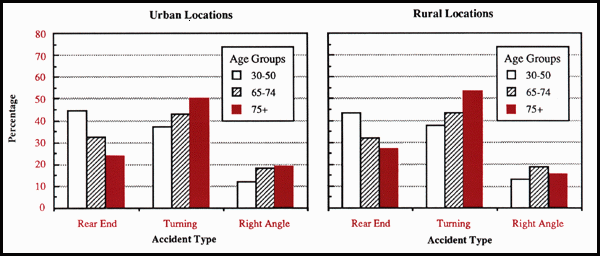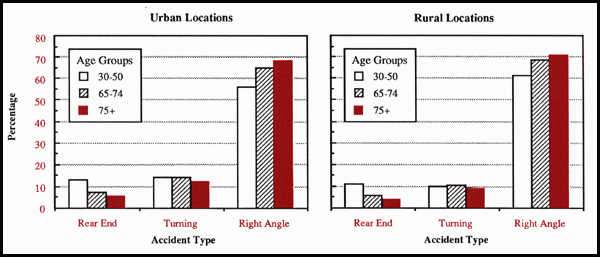Accident Analysis of Older Drivers at Intersections
As the proportion of Americans 65 years of age and older continues to increase, motor vehicle accidents involving older drivers and pedestrians are becoming a significant traffic safety concern. Intersections appear to be particularly hazardous to both elderly drivers and pedestrians. In addition to a literature review and focus groups examining a number of questions of interest with respect to crashes at intersections, this study examined the specific nature of intersection-related crashes involving elderly drivers through a detailed analysis of accident data from the Highway Safety Information System (HSIS). The analyses were conducted as part of the Federal Highway Administration (FHWA) research study, "Traffic Operations Control for Older Drivers."
State Data Bases Used
The authors used HSIS data from 1985 to 1987 in Minnesota and Illinois for this research. These two States had adequate data detail for the variables of interest (e.g., driver age, crash type), as well as relatively large sample sizesof crashes.
Analysis Methods
For all of the analyses, comparisons were made among a "young elderly" group (ages 65 to 74), an "old elderly" group (age 75 and older), and a middle-aged comparison group (ages 30 to 50). The accident types at both urban and rural signalized and stop-controlled intersections were examined separately, as well as the type of vehicle maneuver prior to the crash and the investigating officer’s judgment of "causal" factors. In addition, to help control for possible differences in exposure at different types of intersections (e.g., elderly drivers may more often choose to use signalized intersections and avoid unsignalized intersections), restricted samples of Illinois and Minnesota intersection crashes where one elderly and one middle-aged driver were both present were examined. This ensured that both age groups were using the same intersections.
Results
The more general analyses of accident type in both States indicated that at both urban and rural signalized intersections, elderly drivers were less likely than their middle-aged counterparts to be involved in rear-end collisions, but more likely to be involved in left-turn and angle collisions. (See Figure 1 for Illinois data.)

Figure 1
Also, in both States, right-angle collisions presented a particular problem to elderly drivers at both urban and rural stop-controlled intersections. (See Figure 2 for Minnesota data.)

Figure 2
To further examine these findings, pre-accident driver maneuvers were examined for all Minnesota crashes and for the restricted subset of Illinois crashes in which one elderly and one middle-aged driver were present. In general, the findings of these two analyses were quite similar. For turning collisions at urban and rural signalized intersections, middle-aged drivers tended to have been going straight, while older drivers were more likely to have been turning left, and were slightly more likely to be turning right and turning right on red. (See Table 1 for Illinois data.)
| Table 1. Percentage of involvement for selected
pre-accident maneuvers for turning collisions at signalized intersections (Illinois data). |
| |
Driver Age in Years |
| |
30-50 |
65-74 |
75+ |
| Urban Signalized Intersections |
(1,921) |
(1,246) |
(655) |
|
62.1 |
26.9 |
18.6 |
|
25.4 |
56.5 |
66.9 |
|
7.4 |
12.4 |
10.7 |
|
2.7 |
1.8 |
1.2 |
|
0.3 |
1.4 |
1.8 |
| Rural Signalized Intersections |
(39) |
(22) |
(17) |
|
51.3 |
31.8 |
17.7 |
|
35.9 |
45.5 |
52.9 |
|
7.7 |
18.2 |
17.7 |
In right-angle collisions at both urban and rural stop-controlled intersections, elderly drivers were more likely than middle-aged drivers to have been starting from a stop. In turning collisions, they were more likely to be turning left or right across traffic. (See Table 2.) By comparison, middle-aged drivers were either going straight or slowing or stopping. Note that while there are some crashes at all-way stop-controlled intersections in these data, over 98.5 percent of the stop-controlled intersections in Illinois have two-way stops.
| Table 2. Percentage of involvement for selected
pre-accident maneuvers classified by crash type at stop-controlled intersections (Illinois data). |
| Driver Age in Years |
| |
30-50 |
65-74 |
75+ |
| Urban Stop-Controlled Intersections |
| Angle Collisions |
(772) |
(463) |
(299) |
|
90.9 |
78.6 |
73.9 |
|
6.4 |
19.2 |
23.4 |
| Turning Collisions |
(911) |
(567) |
(326) |
|
58.7 |
30.3 |
19.3 |
|
28.0 |
51.2 |
60.7 |
|
8.0 |
15.3 |
16.9 |
|
3.2 |
1.8 |
1.2 |
| Rural Stop-Controlled Intersections |
| Angle Collisions |
(292) |
(149) |
(137) |
|
91.8 |
78.5 |
67.2 |
|
6.9 |
20.8 |
32.1 |
| Turning Collisions |
(176) |
(104) |
(67) |
|
63.1 |
21.2 |
19.4 |
|
23.3 |
56.7 |
61.2 |
|
6.8 |
11.5 |
16.4 |
|
5.1 |
5.8 |
1.5 |
| Note: Sample sizes for each age group are shown in parentheses. The sum of the sample sizes for the two elderly groups does not exactly equal the sample size for the middle-age group in all cases. This reflects the fact that there were missing data for individual drivers in a limited number of these accident cases. |
Because the elderly drivers appeared to be disproportionally involved in angle and turning crashes, an attempt was then made to examine "causes" of these crashes by investigating the "contributing factors" cited by the officer. In this analysis, a sample of Minnesota right-angle and turning crashes in which both an elderly and a middle-aged driver were involved was examined. Here, similar patterns emerged for both urban and rural signalized and stop-controlled intersections. When turning and angle crashes were combined, the middle-aged driver was consistently more likely to have been cited as having exhibited "no improper driving," while the elderly drivers were more likely to have been noted for "failure to yield." For the four different urban-rural/signal-stop sign combinations, the percentages for "no improper driving" ranged from 65 to 75 percent for middle-aged drivers, to 25 to 33 percent for the young elderly, to 13 to 24 percent for the old elderly.
In a final analysis of these same "cause-related" data (again using only the turning andangle accidents in which both a middle-aged and an elderly driver were involved), the data were categorized by pre-accident maneuver of a given driver, and only the cases in which the driver was either "turning left" or "going straight" at a signalized intersection were examined. While the findings for "no improper driving" paralleled those cited in the preceding paragraph, of most interest here was the fact that when the drivers of different ages who were "going straight" were compared to each other, there was some indication of increased proportions of "disregarding traffic signal" for the elderly drivers (12.2 percent vs. 32.7 percent, vs. 55.0 percent for the three age groups, respectively). In short, this entire set of analyses indicated that the elderly driver was, in the officer's opinion, more often "at fault."
In summary, the accident analyses indicate that both the "young elderly" (ages 65 to 74) and the "old elderly" (age 75 and older) appear to have problems at intersections. These problems often involve left-turning maneuvers (at signalized intersections) and turning or "entering" maneuvers at stop-controlled intersections. It appears that the problemexperienced by elderly drivers involved in crashes either relate to the difficulties in distinguishing target vehicles from surrounding clutter, judging closing speeds of target vehicles, and/or an inability to use the acceleration capabilities of the cars they are driving in order to utilize what would be considered "safe gaps" foryounger drivers.
Study Implications
The study findings, in conjunction with the literature review, focus group discussions involving elderly drivers and pedestrians, and other analyses were used in the development of a listing of possible countermeasures. These included treatments to the intersections themselves (e.g., modification of left-turn signal phase indicators for better understanding, consistency in signal indication and sequence for protected/unprotected left-turn phasing, or elimination of sight-distance restrictions), elderly driver training concerning specific gap-judgment problems, and possible future vehicle-design changes (e.g., radar warning of oncoming vehicles). Some of these countermeasures will be further developed and tested as part of the ongoing FHWA research study on "Traffic Operations Controlfor Older Drivers."
For More Information
The "Operations Control for Older Drivers" study is being conducted by the Center for Applied Research (CAR). The results discussed in this summary were developed by the University of North Carolina Highway Safety Research Center under subcontract to CAR. For more information, contact Forrest Council at (919) 962-2202. For more information on HSIS, contact Jeffrey F. Paniati, HSIS Program Manager.
|